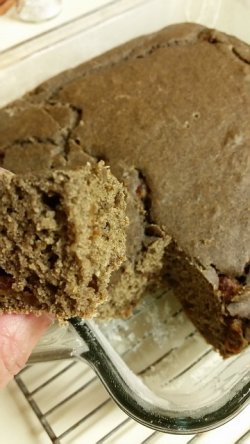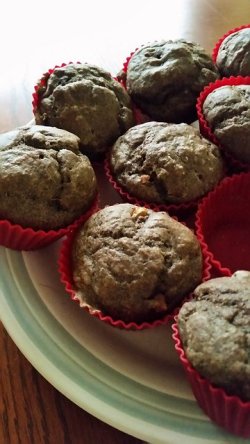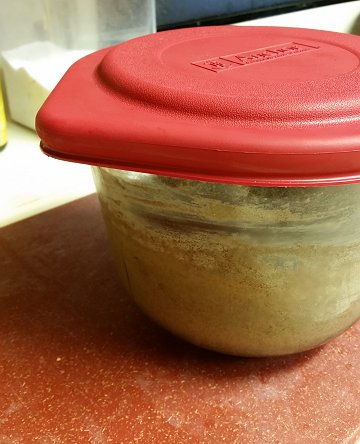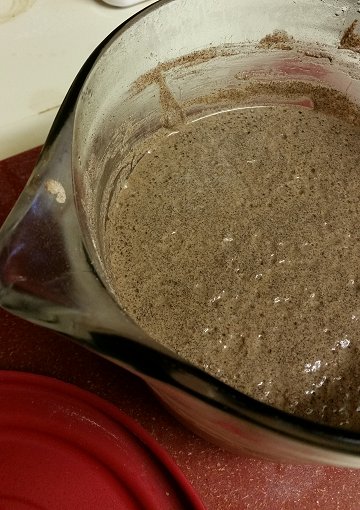I’d never eaten buckwheat cakes until on impulse I bought a bag of mix. Then I was hooked. Being me, of course, I wanted to make them from scratch. Also, typically, I wanted to thrown in a new variable or two into the equation. I had the idea of making sourdough buckwheat because the yeast, I reasoned, would ensure the pancakes were fluffy and had a bit of “lift” since I didn’t trust myself to be able to fake my way through pancake levening, having never made pancakes from scratch. (We’re not regular pancake eaters or I’d have done something like this before now.) Then I stumbled onto a jar of buckwheat honey, which tastes amazing (if you like the flavor of buckwheat, because the honey tastes just like buckwheat cakes, only sweet). I had to incorporate this into my mad buckwheat sourdough scheme somehow.
Researching sourdough starters and buckwheat cakes I found that the proportions for most were a two to one ratio of water to flour, with equal amounts flour and water to feed the starter. Instructions varied widely on the amount of flour and water to use to make the starter and amounts to use to feed, as well as the number of days feeding before it can be used, the frequency of feeding, and the temperature (room temp or refrigerated).
I’d had some experience with starters a long time ago: a neighbor had given me “Herman” which I finally had to throw out because the monster was taking over and I couldn’t keep up with it. Then several years later I bought a sourdough starter and made sourdough bread quite a lot. I don’t remember what brought that to an end, but I seem to recall that the bread tasted worse and worse the longer I used it. Perhaps that famed sourdough tang just got too tangy.
Now here I am, decades later, nursing a sourdough starter again, having not only not learned any lessons from previous experiences, but not even remembering the details of those experiences well enough to guide me this time around. (Which is why it took me two tries to get this right.)
After giving it some thought, I went with 1 cup organic buckwheat flour to 2 cups of lukewarm water. I’m the only one in this household who likes buckwheat cakes, so I didn’t want to end up with enough to feed an army. I dissolved 1 pkg of active dry yeast in 2 cups of warm water, stirred in 1 Tbls buckwheat honey, then 1 cup buckwheat flour. (Bob’s Red Mill brand).
I left the starter in a glass bowl, lightly covered with plastic wrap in a dim room during the week when I was feeding the starter daily.
I started the starter on a Monday, then removed and discarded 1/2 cup Tues and added 1/2 buckwheat flour and 1/2 cup water, stirring well before discarding and stirring well after adding the flour and water. I did this Tues through Friday.
On Saturday I removed 1 cup of the starter and set aside to use for buckwheat cakes. I transferred the remaining starter to a plastic bowl with a lid. I added 1 cup buckwheat flour, 1 warm water to the remaining starter mixture. I left the starter out, covered, while making pancakes, then refrigerated the starter. I didn’t touch the starter again until Saturday.
Saturday morning I took the starter out of the fridge for an hour or so, then removed 1 cup for pancakes and added 1 cup warm water and 1 cup buckwheat flour to the starter. I left it out, covered, while I made buckwheat cakes, then refrigerated it again until the next Saturday.
Thereafter I fed the starter once a week, usually on Saturday or Sunday, removing 1 cup of the starter which I used to make buckwheat cakes.
The starter and pancake batter develop a wonderful spongy, almost mousse-like texture over time. The buckwheat cakes are thick, fluffy, and very filling.
For buckwheat cakes:
1 cup buckwheat starter
1 cup buckwheat flour
1 tsp baking soda
1/2 tsp salt
3/4 cup milk
1 egg
2 Tbls oil
2 Tbls buckwheat honey (or other honey)
Stir all ingredients together, until no lumps remain. (I add ingredients in order listed, stirring flour into the starter a little bit, then adding everything else on top and stirring it all together at once.)
Preheat lightly greased griddle. I cook the pancakes on “5” on my electric stove, which is the exact midpoint setting. Higher and they tended to burn, lower and they tended to stick. You’ll need to experiment a bit to find the right temperature on your stove. I grease the griddle with a small amount of cooking oil. I don’t measure this, but if I had to guess, I’d say 1-2 Tbls.
Scoop out by 1/3 measuring cup of batter and pour onto lightly greased griddle. This is a thick batter, which makes a fluffy tender pancake. I scoop out the batter from the cup with my finger and then spread the pancake on the griddle using the bottom of the measuring cup swirling outward in a spiral until the batter is evenly distributed in a circle several inches in diameter in the center of the griddle. (If you prefer a thinner pancake batter and thinner pancakes, adding a little bit more milk should do the trick.)
Conventional wisdom says to turn pancakes when they start to bubble in the middle. I would add one other requirement: the edges of the buckwheat cakes need to show signs of being cooked or being firm. The edge will look slightly dry. The pancakes are delicate and you’ll need a firm edge to get underneath and flip them. I usually cook mine about a minute to a minute and a half on the first side, then slightly less time on the other side.
Serve with butter or margarine and maple syrup. If you want sweeter, with a stronger buckwheat flavor, try drizzling some buckwheat honey over the pancakes instead of maple syrup. If the edges of the pancakes are too crumbly when you start eating, this just means they didn’t get enough margarine (or butter) or syrup. 🙂
This recipe makes 7-8 pancakes. They’re very filling. (I usually only eat two, three if I’m ravenous and don’t mind feeling stuffed afterward — and that’s if I’m only having buckwheat cakes. It’s more like one or two if there’s other things on the breakfast table. Your mileage may vary.) If you don’t use all the batter on Saturday morning, cover it and refrigerate it, then take it out and use it up Sunday morning! 😉
The next Saturday, remove a cup of starter to make pancakes and feed the starter 1 cup buckwheat flour and 1 cup lukewarm water. Refrigerate until the next weekend. If you don’t make pancakes every weekend, throw out the starter that’s removed (or use in another recipe) and feed the starter, then refrigerate the starter. The starter must be tended weekly, removing some and feeding with more flour and water, whether you make pancakes or not.
Don’t worry if you can’t make pancakes on Saturday: it won’t hurt anything to wait until Sunday to make pancakes and feed the starter. You just need to remove some starter and feed the starter sometime each weekend.



